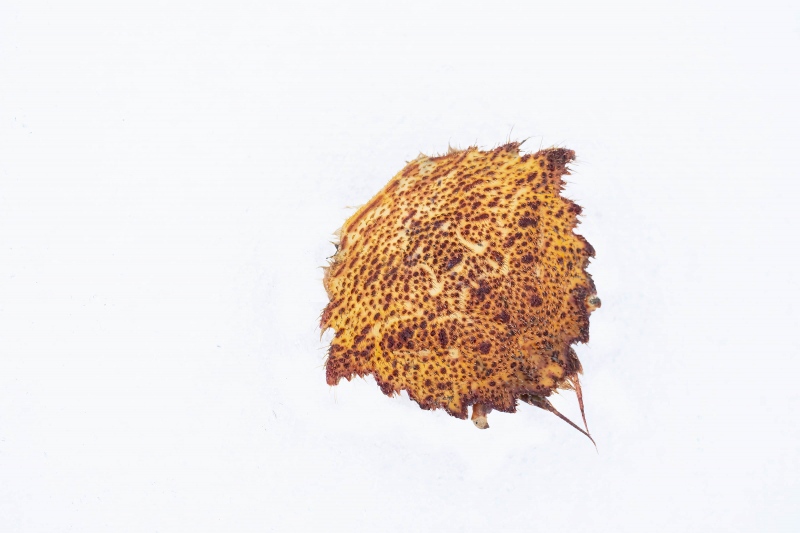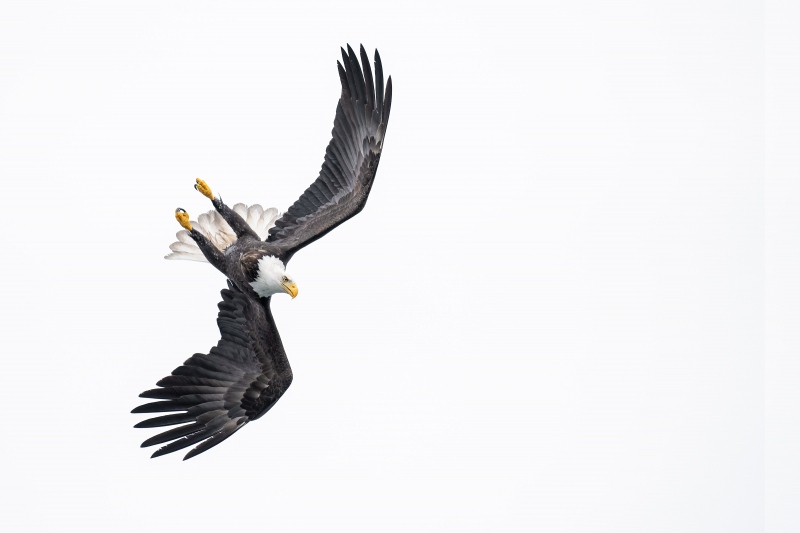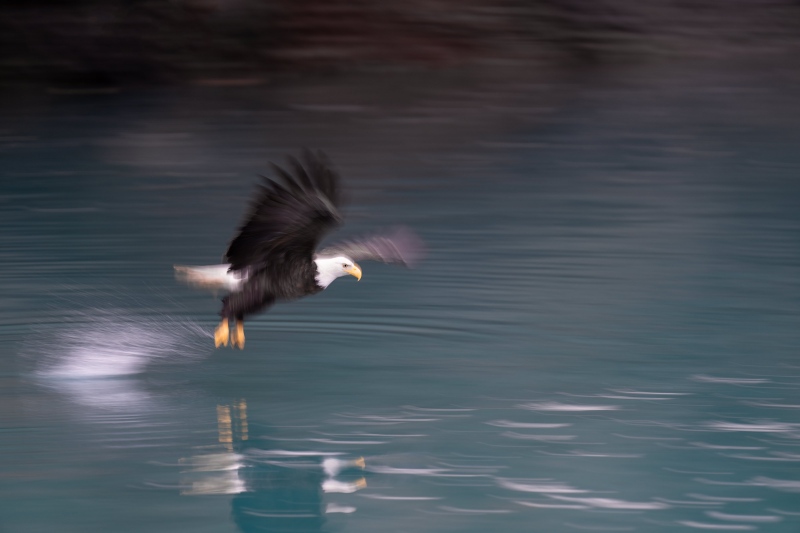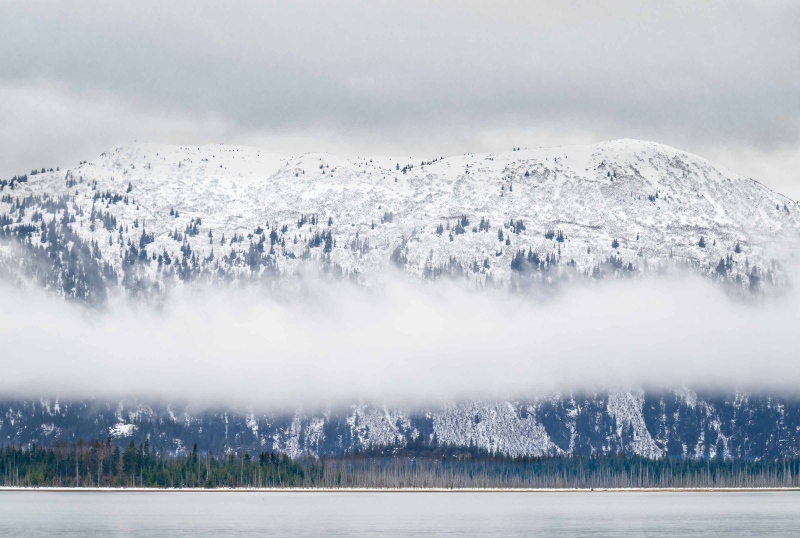Your Call
All are invited to leave a comment stating their preference for each of today’s four featured images. Please put them in order with your favorite image first and your least favorite of the four. Ambitious folks can comment on why they made their choices. I will share my list and my reasons with you here tomorrow.
What’s Up?
Thursday was the least fantastic day of the first Homer/Kachemak Bay IPT. That said, the day was filled with great photo chances and provided countless opportunities for folks to learn. And learn they did. Carolyn created her first a1 videos of flying eagles. Vasili, Carolyn, and Bob Eastman all worked on creating pleasing blurs at the end of the day. And Bear Bob learned that he should have listened to me and brought his Canon 70-200mm f/2.8 lens on the trip. In low light conditions, that lens shines no matter what system you are using. Except for Robert Sabine who left his home, it has been everyone’s most valuable lens by far.
In yesterday’s blog post, my favorites, in order, were 2, 3, and 1. Image #2 was pretty much perfect but it would have been nice to have had the second talon dropped down (as Adam suggested). I loved the three amigo eagles for its sharpness, the image design, and the single calling bird. #1 was OK but I plan on trying for something similar but more dynamic.
Today is Friday 24 February 2023. I just heard from Captain Gabe who called off sailing today because of small craft warnings with five to eight foot seas in the forecast. We have lots of image review and Photoshop to catch up on and we did get in 19 3/4 of our allotted 20 hours on the boat.
This blog post took about two hours to prepare (including the time spent on the image optimizations) and makes three hundred thirty-one days in a row with a new educational post written just for you. Wherever you are and whatever you are doing, I hope that you too have a great day.
Please, please, pretty please remember to use my B&H or Bedford’s affiliate programs for all your new gear purchases. If you use B&H, please be sure to click on any B&H link in the blog to start your search. Or simply start with this link. There is always the option of e-mailing me for gear advice and for the correct links.
The plan is to continue to post every day until the streak reaches one year and one day and then begin posting every other day.
Please remember to use the B&H and Amazon links that are found on most blog pages and to use the BIRDSASART discount code at checkout when purchasing your new gear from Bedfords to get 3% back on your credit card and enjoy free second-day air FedEx. Please, also, consider joining a BAA IPT. You will be amazed at how much you will learn!
You can find some great photo accessories (and necessities, like surf booties!) on Amazon by clicking on the Stuff tab on the orange/yellow menu bar above. On a related note, it would be extremely helpful if blog-folks who, like me, spend too much money on Amazon, would get in the habit of clicking on the Amazon logo link on the right side of each blog post when they shop online. As you might expect, doing so will not cost you a single penny, but would be appreciated tremendously by yours truly. And doing so, works seamlessly with your Amazon Prime account.
Please remember that if an item — a Delkin flash card, or a tripod head — for example, that is available from B&H and/or Bedfords, is also available in the BAA Online Store, it would be great, and greatly appreciated, if you would opt to purchase from us. We will match any price. Please remember also to use my B&H affiliate links or to earn 3% cash back at Bedfords by using the BIRDSASART discount code at checkout for your major gear purchases. Doing either often earns you free guides and/or discounts. And always earns my great appreciation.
|
|
|
This image was created on 23 February 2023 on Day Four of the first Homer Bald Eagle IPT at Kachemak Bay, AK. I used the hand held Sony FE 70-200mm f/2.8 GM OSS II lens (at 200mm) and The One, the Sony Alpha 1 Mirrorless Digital Camera.. The exposure was determined via Zebras with Exposure Compensation on the thumb dial. ISO 1250: 1/250 sec. at f/8 (stopped down four stops) in Manual mode. AWB at 11:25:08 am on a dark, dingy morning. Tracking: Spot S AF/C performed perfectly. Click on the image to enjoy a high-res version. Image #1: Crab shell on snow |
The Sony 70-200 f/2.8II GM as a Quasi-Macro Lens
After trying and failing to get some eagles to land on moose antlers, several of us looked along the wrack line for something to photograph. We did some shell and seaweed close-ups. We shot some stuff in situ, and we placed some stuff like this crab shell on an area of unblemished snow. Most of the 70-200 f/2.8 lenses have a decent close focus. The Sony version II has an outstanding Minimum Focusing Distance (MFD) of 15.7 inches. I think that that is at 70mm and is increased a bit as you go to longer focal lengths. IAC, you are able to get right over a subject and shoot straight down.
Why f/8?
|
|
|
This image was also created on 23 February 2023 on Day Four of the first Homer Bald Eagle IPT at Kachemak Bay, AK. Again, I used the hand held Sony FE 70-200mm f/2.8 GM OSS II lens (at 200mm) and The One, the Sony Alpha 1 Mirrorless Digital Camera.. The exposure was determined via Zebras with Exposure Compensation on the thumb dial. ISO 1600: 1/2500 sec. at f/2.8 (wide-open) in Manual mode. AWB at 4:00:50pm on a very dark, dingy morning. Tracking: Zone AF/C performed perfectly. Click on the image to enjoy a high-res version. Image #2: Bald Eagle adult beginning dive |
The Sony 70-200 f/2.8II GM as a Super-fast Low Light Flight and Action Lens
The weather in Alaska is always variable. Yesterday was on the dark side with a few sprinkles of rain here and there. With the birds at close range, the bare (i.e., no TC) 70-200 II is the ticket to success, allowing for the use of high shutter speeds and relatively low ISO settings. On brighter days, the addition of the 1.4X TC gives you more reach when needed. Not to mention that the lens is relatively tiny and light allowing pretty much everyone to be able to handhold it for long flight photography sessions.
|
|
|
This image was also created on 23 February 2023 on Day Four of the first Homer Bald Eagle IPT at Kachemak Bay, AK. I used the hand held Sony FE 70-200mm f/2.8 GM OSS II lens with the Sony FE 1.4x Teleconverter (at 185mm) and The One, the Sony Alpha 1 Mirrorless Digital Camera.. The exposure was determined via Zebras. ISO 160: 1/30 sec. at f/4 (wide-open) in Manual mode. AWB at 7:52:16am on a dark, dingy morning. Tracking: Spot Zone AF/C with Bird-Eye/Face Detection performed perfectly. Click on the image to enjoy a high-res version. Image #3: Bald Eagle striking blur |
The Sony 70-200 f/2.8II GM as a Blur Lens
Most any intermediate telephoto lens would work well for blurs. The beauty of the 70-200 is that it is light and the zoom is smooth and fast. With the 1.4X in place here I had the extra reach when I needed it. And AF with the Sony version II is vastly improved over the original model.
|
|
|
This image was also created on 23 February 2023 on Day Four of the first Homer Bald Eagle IPT at Kachemak Bay, AK. I used the hand held Sony FE 70-200mm f/2.8 GM OSS II lens (at 200mm) and The One, the Sony Alpha 1 Mirrorless Digital Camera.. The exposure was determined via Zebras with Exposure Compensation on the thumb dial. ISO 320: 1/160sec. at f/4 (stopped down one stop) in Manual mode. AWB at 5:22:54pm on a cloudy afternoon. Tracking: Expand Spot AF/C performed just fine. Click on the image to enjoy a high-res version. Image #4: Snow-covered mountain-side with fog bank |
The Sony 70-200 f/2.8II GM as a Landscape Lens
No matter the manufacturer, the 70-200 lenses are favored by many professionals and talented amateurs for scenic and landscape photography. The raw file for this image was blah, blah, blah. The raw conversion helped and I used Viveza from the NIK Collection to add texture to the white sky and to brighten and color up the row of trees (both alive and dead).
Summing Up
The 70-200mm lenses are extremely versatile. I could have added 100 very different images to this post, all made on the first Homer IPT.
Typos
With all blog posts, feel free to e-mail or to leave a comment regarding any typos or errors.


















Guessing F/8 to get more dof given that for 200mm the dof at around 5 feet distance the whole dof would be .08 feet (about an inch) including the in front of and the behind the focus point. (coc at 0.03mm) If you were at 10 feet the total dof would be about 4 inches total. Not a lot to work with.
Order of preference: 3 2 1 4
Stay warm up there.
Thanks, Guido. I was at about 3.5 feet. I needed more DOF because the shell is curved. I did not quite have enough to cover the front of the carapace.
with love, a
Order of selection….: 3,2,1
3: balance, feeling of movement, and appreciation of the difficulty of panning and getting the eye sharp
2: Almost picked as #1. dramatic position and sharpness. Hope the eagle has an FAA low altitude aerobatic waiver.
Thanks, Doc. #3 is my favorite also. I shocked myself by getting the eye sharp at 1/30 sec.
with love, artie
ps: glad that you liked the crane shell.
#1 I don’t really get it.
#2 Speaks for its self. Very nice.
#3 Work on the head blur in PS and you’ve got a winner!
#4 Lovely horizon and straight lines.
Hi Anthony,
#1: nothing to get — it is a studio-like graphic design. Either you like it or not 🙂
#2: With the mirrorless bodies an image that used to win contests has become commonplace.
#3: I thought about eliminating the bill/head blur and decided not to. But you cannot win most contests if you do that 🙂
#4: I did need to rotate the canvas a bit.
thanks for your thoughtful comments.
a
Image #1 Crab shell on snow and Image #3 Bald Eagle striking blur are not too good. Image #1 is at a weird area and Image #3 is not well monitored. Image #2 Bald Eagle adult beginning dive and Image #4 Snow-covered mountain-side with fog bank are well made and interesting to see!